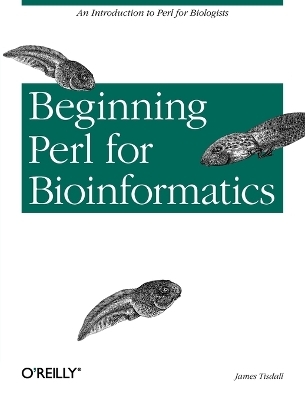
Beginning Perl for Bioinformatics
O'Reilly Media (Verlag)
978-0-596-00080-6 (ISBN)
James Tisdall has worked as a musician, as a programmer at Bell Labs (where he programmed for speech research and discovered a formal language for musical rhythm), at the Human Genome Project in the Computational Biology and Informatics Laboratory (where he began using Perl for bioinformatics in 1991), at Mercator Genetics in Menlo Park, California, and most recently at the Fox Chase Cancer Center in Philadelphia. He has a BA in mathematics from the City College of New York; an MS in computer science from Columbia University; and is working towards a Ph.D. in computer science at the University of Pennsylvania. In his spare time Jim teaches computer music at the Settlement Music School in Philadelphia.
Preface. 1. Biology and Computer Science The Organization of DNA The Organization of Proteins In Silico Limits to Computation. 2. Getting Started with Perl A Low and Long Learning Curve Perl's Benefits Installing Perl on Your Computer How to Run Perl Programs Text Editors Finding Help. 3. The Art of Programming Individual Approaches to Programming Edit-Run-Revise (and Save) An Environment of Programs Programming Strategies The Programming Process. 4. Sequences and Strings Representing Sequence Data A Program to Store a DNA Sequence Concatenating DNA Fragments Transcription: DNA to RNA Using the Perl Documentation Calculating the Reverse Complement in Perl Proteins, Files, and Arrays Reading Proteins in Files Arrays Scalar and List Context Exercises. 5. Motifs and Loops Flow Control Code Layout Finding Motifs Counting Nucleotides Exploding Strings into Arrays Operating on Strings Writing to Files Exercises. 6. Subroutines and Bugs Sbroutines Scoping and Subroutines Command-Line Arguments and Arrays Passing Data to Subroutines Modules and Libraries of Subroutines Fixing Bugs in Your Code Exercises. 7. Mutations and Randomization Random Number Generators A Program Using Randomization A Program to Simulate DNA Mutation Generating Random DNA Analyzing DNA Exercises. 8. The Genetic Code Hashes Data Structures and Algorithms for Biology The Genetic Code Translating DNA into Proteins Reading DNA from Files in FASTA Format Reading Frames Exercises. 9. Restriction Maps and Regular Expressions Regular Expressions Restriction Maps and Restriction Enzymes Perl Operations Exercises. 10. GenBank GenBank Files GenBank Libraries Separating Sequence and Annotation Parsing Annotations Indexing GenBank with DBM Exercises. 11. Protein Data Bank Files and Folders PDB Files Parsing PDB Files Controlling Other Programs Exercises 12. BLAST Obtaining BLAST String Matching and Homology BLAST Output Files Parsing BLAST Output Presenting Data Bioperl Exercises. 13. Further Topics The Art of Program Design Web Programming Algorithms and Sequence Alignment Object-Oriented Programming Perl Modules Complex Data Structures Relational Databases Microarrays and XML Graphics Programming Modeling Networks DNA Computers A. Resources B. Perl Summary Index
| Erscheint lt. Verlag | 27.11.2001 |
|---|---|
| Verlagsort | Sebastopol |
| Sprache | englisch |
| Einbandart | kartoniert |
| Themenwelt | Informatik ► Programmiersprachen / -werkzeuge ► Perl |
| Naturwissenschaften ► Biologie | |
| ISBN-10 | 0-596-00080-4 / 0596000804 |
| ISBN-13 | 978-0-596-00080-6 / 9780596000806 |
| Zustand | Neuware |
| Haben Sie eine Frage zum Produkt? |
aus dem Bereich
